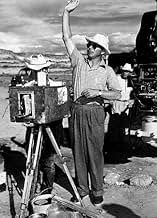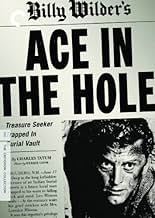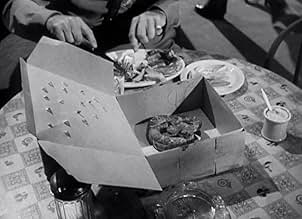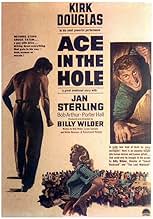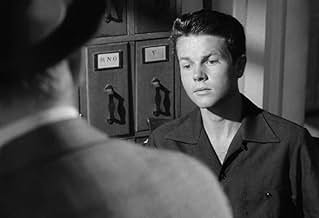IMDb RATING
8.1/10
41K
YOUR RATING
Frustrated former journalist Chuck Tatum now working for an Albuquerque newspaper exploits a story about trading post owner Leo Minosa trapped in a cave to rekindle Chuck's career, but the s... Read allFrustrated former journalist Chuck Tatum now working for an Albuquerque newspaper exploits a story about trading post owner Leo Minosa trapped in a cave to rekindle Chuck's career, but the story soon escalates into a media circus.Frustrated former journalist Chuck Tatum now working for an Albuquerque newspaper exploits a story about trading post owner Leo Minosa trapped in a cave to rekindle Chuck's career, but the story soon escalates into a media circus.
- Nominated for 1 Oscar
- 5 wins & 3 nominations total
Robert Arthur
- Herbie Cook
- (as Bob Arthur)
Roy Regnier
- Nagel - New York Editor (replaced by Richard Gaines)
- (scenes deleted)
Oscar Belinda
- Barker
- (uncredited)
Featured reviews
10castolon
The movie very closely parallels the real events of January 30 to February 16, 1925 in terms of the general story line. There are some significant differences concerning the actions of the characters.
Floyd Collins, a cave explorer working alone (not a real good idea), was trapped in Sand Cave KY, near Mammoth Cave. He was not looking for treasure, but for a new cave suitable for commercializing to produce income in an economically depressed region...and this was before the Depression occurred.
He became trapped on the way out of the cave by a 27 lb. rock which rolled onto his leg in a narrow crawlway. The configuration was such that it could not be moved enough to get his foot past.
When he failed to return home, the family went searching and quickly found him only 150' inside the cave.
A huge rescue effort was mounted and a cub reporter, Skeets Miller, from Louisville KY showed up to cover the story. It became one of the three most widely broadcast events of the time. Besides the extensive newspaper coverage, the relatively new medium of commercial radio riveted listeners with hourly accounts. It quickly became the first media circus ever seen.
Because of the print and radio coverage people began flocking to the site. A carnival atmosphere did indeed spring up around the cave. The state police and National Guard were called out by the governor to control the chaos and the more than 20,000 onlookers. The similarity between the real event and the movie on this account are likely nearly identical.
As in the movie, a decision was made to drill a shaft and, also as in the movie, the rock was fairly unstable and prone to collapse from the pounding of the cable tool drilling rig. The longer the effort went on, the more unstable the cave passage became.
Unlike Kirk Douglas' character in the movie, Skeets Miller served a most honorable role. Due to his small build he became one of very few persons able, and eventually the only one willing, to enter in an attempt to deliver food and water to Collins. He received a Pulitzer Prize for his reporting. Also unlike the movie, there was no manipulation of the event to delay the rescue, but there was considerable disagreement over how to best do it. Area coal miners made the initial attempts and the event concluded with the above-mentioned shaft.
Collins was presumed to have died 3 days before rescuers reached him. Because the conditions were so unstable, the body was left in the cave. The family was able to remove him about 80 days afterward for a proper burial. Later, his glass-topped casket was returned to the now-commercial cave as a tourist attraction. It was removed once again, and finally, in 1989.
In 1982, a definitive account of the event was published in the book 'Trapped!'. A most informative read.
In a take-off of the 'Free Tibet' bumper stickers, vehicles are occasionally seen with a 'Free Floyd Collins' sticker.
Floyd Collins, a cave explorer working alone (not a real good idea), was trapped in Sand Cave KY, near Mammoth Cave. He was not looking for treasure, but for a new cave suitable for commercializing to produce income in an economically depressed region...and this was before the Depression occurred.
He became trapped on the way out of the cave by a 27 lb. rock which rolled onto his leg in a narrow crawlway. The configuration was such that it could not be moved enough to get his foot past.
When he failed to return home, the family went searching and quickly found him only 150' inside the cave.
A huge rescue effort was mounted and a cub reporter, Skeets Miller, from Louisville KY showed up to cover the story. It became one of the three most widely broadcast events of the time. Besides the extensive newspaper coverage, the relatively new medium of commercial radio riveted listeners with hourly accounts. It quickly became the first media circus ever seen.
Because of the print and radio coverage people began flocking to the site. A carnival atmosphere did indeed spring up around the cave. The state police and National Guard were called out by the governor to control the chaos and the more than 20,000 onlookers. The similarity between the real event and the movie on this account are likely nearly identical.
As in the movie, a decision was made to drill a shaft and, also as in the movie, the rock was fairly unstable and prone to collapse from the pounding of the cable tool drilling rig. The longer the effort went on, the more unstable the cave passage became.
Unlike Kirk Douglas' character in the movie, Skeets Miller served a most honorable role. Due to his small build he became one of very few persons able, and eventually the only one willing, to enter in an attempt to deliver food and water to Collins. He received a Pulitzer Prize for his reporting. Also unlike the movie, there was no manipulation of the event to delay the rescue, but there was considerable disagreement over how to best do it. Area coal miners made the initial attempts and the event concluded with the above-mentioned shaft.
Collins was presumed to have died 3 days before rescuers reached him. Because the conditions were so unstable, the body was left in the cave. The family was able to remove him about 80 days afterward for a proper burial. Later, his glass-topped casket was returned to the now-commercial cave as a tourist attraction. It was removed once again, and finally, in 1989.
In 1982, a definitive account of the event was published in the book 'Trapped!'. A most informative read.
In a take-off of the 'Free Tibet' bumper stickers, vehicles are occasionally seen with a 'Free Floyd Collins' sticker.
This is a movie I have loved since the first time I saw it as a child. Kirk Douglas plays the lead role in "The Big Carnival", or "Ace in the Hole" as it was originally titled. As down and out former ace newspaper reporter Chuck Tatum, he finds himself broke in the southwest and manages to talk himself into a reporting job with a small town newspaper. He and a cub photographer are sent to cover a snake hunt and on the way they come across a more interesting story. A man hunting Navaho artifacts got caught in a cave in.
Tatum, after visiting the man, Leo Minoso in the cave, has visions of Floyd Collins and a Pulitzer prize dancing in his head. Through blackmail and manipulation of the story, Tatum sells his soul and his journalistic ethics in his quest for a chance at the big time again.
This movie was ahead of it's time in estimating how low the media would go to sell a story. Tatum leads the carnival of onlookers, vendors and other reporters wanting a piece of the story until the inevitable tragic ending occurs. He realizes too late how he has turned a simple event into a tragedy and become part of the story instead of a reporter. Kirk Douglas turns in a powerful performance.
Tatum, after visiting the man, Leo Minoso in the cave, has visions of Floyd Collins and a Pulitzer prize dancing in his head. Through blackmail and manipulation of the story, Tatum sells his soul and his journalistic ethics in his quest for a chance at the big time again.
This movie was ahead of it's time in estimating how low the media would go to sell a story. Tatum leads the carnival of onlookers, vendors and other reporters wanting a piece of the story until the inevitable tragic ending occurs. He realizes too late how he has turned a simple event into a tragedy and become part of the story instead of a reporter. Kirk Douglas turns in a powerful performance.
A powerful toasting of the media of the day. Imagine what this would have been like in the age of television. Kirk Douglas plays a self-centered heel, and does so very well. I also liked Jan Sterling as Lorraine. It's true that there is no really sympathetic character in this film, except maybe Leo, the man trapped in the cave. Someone wrote that he too, wasn't a sympathetic character, because he was trapped while collecting Indian artifacts for sale, but I don't think that would have bothered anyone in 1951. The tone of the film throughout was one of total cynicism, that seems a bit out of place for the times. Maybe that's why this movie was not a commercial success. It fits much better now, though, since everyone has seen the media behaving in such disgraceful fashion. However, that may rob it of some of its (probably intended) shock value. Grade: A
I still have to give this film a 7 out of 10 for the subject is a very important and timeless one, that of media manipulation. But the film is anything but subtle. I grant that this acting style of which I complain is very much of the period, but the declamatory nature of Tatum's character comes on way too strong, and makes what could have been a complex character into a very one dimensional one. The overall effect of this and the rest of the writing leaves one with the feeling of being bludgeoned, rather than being exposed to a very disturbing and pervasive phenomena. Could have been handled with more subtlety and delivered greater impact.
Billy Wilder's first commercial failure, but one of his best films, almost up there with "Sunset Blvd." Ambitious reporter Chuck Tatum (Kirk Douglas) finds out a man is trapped in a collapsed mine. By spewing out bogus engineering, he manages the rescue of the poor man to become more complicated, and time consuming then needed. Meanwhile, it becomes an amazing news item, something that makes Tatum the best known reporter in the country. However, everybody's luck runs out at the end. Perhaps the cause of failure of this film is that there are no sympathetic characters here. Douglas plays a total creep, the trapped man's wife is a floozy "I'm not going to pray for him! Praying ruins my nylons!" in the film. Even the trapped man is somebody who was poking around Indian graves. The screenplay, and the lead performances are top class. The extensive location photography, and somewhat documentary look of the film makes the film feel more modern than most 1951 films. Billy Wilder calls this film "the runt of his litter" Don't be so harsh, Billy, it's an excellent picture!
Did you know
- TriviaAfter the film was released, it got bad reviews and lost money. The studio, without Billy Wilder's permission, changed the title to "The Big Carnival" to increase the box office take of the film. It didn't work. On top of that, Wilder's next picture, Stalag 17 (1953), was a hit and he expected a share of the picture's profits. Paramount's accountants told him that since this picture lost money, the money it lost would be subtracted from the profits of "Stalag 17".
- GoofsWhen Lorraine and Chuck are talking out in front of Minosa's store by the gas pumps, reflections of the crew moving around behind the camera can be seen in the store windows.
- Quotes
Charles Tatum: Bad news sells best. Cause good news is no news.
- ConnectionsFeatured in AFI Life Achievement Award: A Tribute to Billy Wilder (1986)
- SoundtracksThe Hut-Sut Song
(uncredited)
Written by Leo Killion, Ted McMichael and Jack Owens
Sung by Richard Benedict and Kirk Douglas
Details
- Release date
- Country of origin
- Languages
- Also known as
- Ace in the Hole
- Filming locations
- Laguna Pueblo, New Mexico, USA(church exteriors)
- Production company
- See more company credits at IMDbPro
Box office
- Budget
- $1,800,000 (estimated)
- Gross worldwide
- $2,300,087
- Runtime1 hour 51 minutes
- Color
- Aspect ratio
- 1.37 : 1
Contribute to this page
Suggest an edit or add missing content



